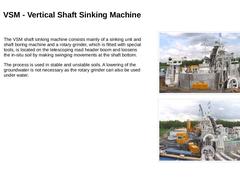
|

The VSM shaft sinking machine consists mainly of a sinking unit and shaft boring machine and a rotary grinder, which is fitted with special tools, is located on the telescoping road header boom and loosens the in-situ soil by making swinging movements at the shaft bottom. The process is used in stable and unstable soils. A lowering of the groundwater is not necessary as the rotary grinder can also be used under water. |
|
(Image: VSM shaft sinking … |
|
|
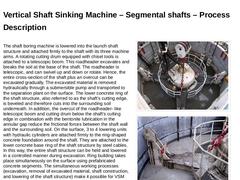
|

The shaft boring machine is lowered into the launch shaft structure and attached firmly to the shaft with its three machine arms. A rotating cutting drum equipped with chisel tools is attached to a telescopic boom. This roadheader excavates and breaks the soil at the base of the shaft. The roadheader is telescopic, and can swivel up and down or rotate. Hence, the entire cross-section of the shaft plus an overcut can be excavated gradually. The excavated … |
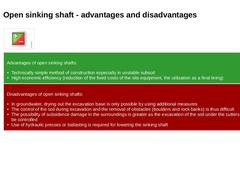
|

| (Image: Pros and cons) | | Advantages of open sinking shafts: - Technically simple method of construction especially in unstable subsoil
- High economic efficiency (reduction of the fixed costs of the site equipment, the utilization as a final lining)
| | Disadvantages of open sinking shafts: - In groundwater, drying out the excavation base is only possible by using additional measures
- The control of the soil during excavation and the removal of obstacles (boulders …
|
|

|

|
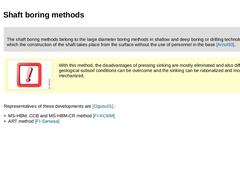
|

The shaft boring methods belong to the large diameter boring methods in shallow and deep boring or drilling technology in which the construction of the shaft takes place from the surface without the use of personnel in the base [Arnol93]. |
|
|
|
(Image: Attention!)
With this method, the disadvantages of pressing sinking are mostly eliminated and also difficult geological subsoil conditions can be overcome and the sinking can be rationalized and mostly … |
|
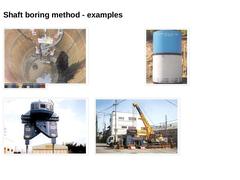
|

(Image: CCB method: shaft boring method with reinforced concrete upper shaft rings for use in soil [FI-KCMM] - Inserting the core boring crown with torsion resisting connected reinforced concrete shaft rings in the rotary table) (Image: CCB method: shaft boring method with reinforced concrete upper shaft rings for use in soil [FI-KCMM] - Reinforced concrete shaft ring with removable steel upper shaft ring placed on top) (Image: MS-HBM-CR method (… |

|

|

|

(Table: Creation of the exit and entry openings with reference to the type of lining [FI-Steina]) |
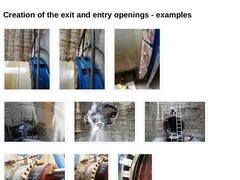
|

(Image: Exit opening with dopple elastomer ring seal and recoil brake) (Image: Exit opening with dopple elastomer ring seal and recoil brake) (Image: Exit opening with dopple elastomer ring seal and recoil brake - Detail) (Image: Entry opening in a target pit of spray concrete without groundwater - Opening has a limited reinforcement ratio) (Image: Entry opening in a target pit of spray concrete without groundwater - Breakthrough of the tunneling … |
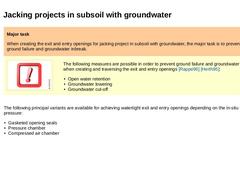
|

|
Major task When creating the exit and entry openings for jacking project in subsoil with groundwater, the major task is to prevent ground failure and groundwater inbreak. |
|
(Image: Attention!) |
The following measures are possible in order to prevent ground failure and groundwater inflows when creating and traversing the exit and entry openings [Rappe96] [Herth95]: -
Open water retention
-
Groundwater lowering
-
Groundwater cut-off
|
|
The following principal … |
|
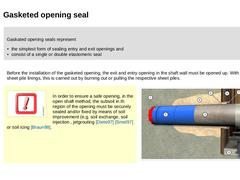
|

Gaskated opening seals represent -
the simplest form of sealing entry and exit openings and
-
consist of a single or double elastomeric seal
|
Before the installation of the gasketed opening, the exit and entry opening in the shaft wall must be opened up. With steel sheet pile linings, this is carried out by burning out or pulling the respective sheet piles. |
|
(Image: Attention!)
In order to ensure a safe opening, in the open shaft method, the subsoil … |
|
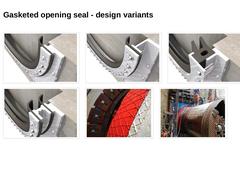
|

(Image: Elastomeric seal ring for gasketed openings for sealing exit- and entry openings - Single seal (fixed with loose flange)) (Image: Elastomeric seal ring for gasketed openings for sealing exit- and entry openings - Single seal) (Image: Elastomeric seal ring for gasketed openings for sealing exit- and entry openings - Double seal) (Image: Elastomeric seal ring for gasketed openings for sealing exit- and entry openings - Double single seal) (Image: … |
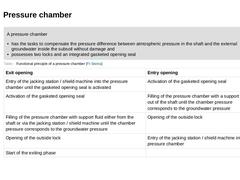
|

|
A pressure chamber - has the tasks to compensate the pressure difference between atmospheric pressure in the shaft and the external groundwater inside the subsoil without damage and
- possesses two locks and an integrated gasketed opening seal
| | (Table: Functional principle of a pressure chamber [FI-Steina]) |
|
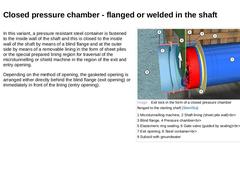
|

In this variant, a pressure resistant steel container is fastened to the inside wall of the shaft and this is closed to the inside wall of the shaft by means of a blind flange and at the outer side by means of a removable lining in the form of sheet piles or the special prepared lining region for traversal of the microtunnelling or shield machine in the region of the exit and entry opening. Depending on the method of opening, the gasketed opening … |
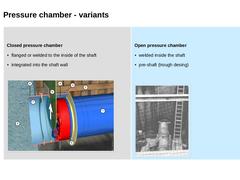
|

Closed pressure chamber (Image: Exit lock in the form of a closed pressure chamber flanged to the starting shaft [Stein05a]) |
Open pressure chamber
(Image: Open pressure chamber welded to the inside of the shaft) |
|
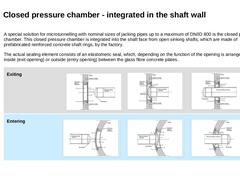
|

|
A special solution for microtunnelling with nominal sizes of jacking pipes up to a maximum of DN/ID 800 is the closed pressure chamber. This closed pressure chamber is integrated into the shaft face from open sinking shafts, which are made of prefabricated reinforced concrete shaft rings, by the factory. The actual sealing element consists of an elastomeric seal, which, depending on the function of the opening is arranged either inside (exit opening) … |
|
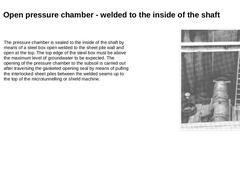
|

The pressure chamber is sealed to the inside of the shaft by means of a steel box open welded to the sheet pile wall and open at the top. The top edge of the steel box must be above the maximum level of groundwater to be expected. The opening of the pressure chamber to the subsoil is carried out after traversing the gasketed opening seal by means of pulling the interlocked sheet piles between the welded seams up to the top of the microtunnelling … |
|
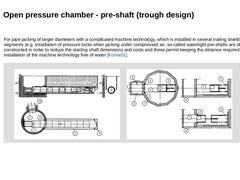
|

For pipe jacking of larger diameters with a complicated machine technology, which is installed in several trailing shield segments (e.g. installation of pressure locks when jacking under compressed air, so-called watertight pre-shafts are often constructed in order to reduce the starting shaft dimensions and costs and these permit keeping the distance required for full installation of the machine technology free of water [Konra01]. |
|
|
|
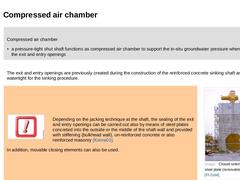
|

Compressed air chamber -
a pressure-tight shut shaft functions as compressed air chamber to support the in-situ groundwater pressure when opening the exit and entry openings
|
The exit and entry openings are previously created during the construction of the reinforced concrete sinking shaft and made watertight for the sinking procedure. |
|
(Image: Attention!)
Depending on the jacking technique at the shaft, the sealing of the exit and entry openings … |
|
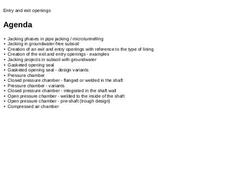
|

|
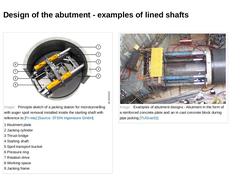
|

(Image: Principle sketch of a jacking station for microtunnelling with auger spoil removal installed inside the starting shaft) (Image: Examples of abutment designs - Abutment in the form of a reinforced concrete plate and an in cast concrete block during pipe jacking [TUGraz01]) |
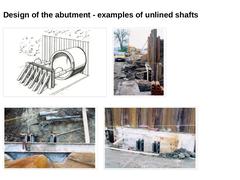
|

(Image: Abutment design without shaft - Sketch [PJA83]) (Image: Abutment design without shaft - Of rammed sheet piles with filling and load distribution plate in front [FI-Zübli]) (Image: Abutment design without shaft - Plan view with backfilled intermediate spaces [FI-Zübli]) (Image: Abutment design without shaft - Front view [FI-Zübli]) |

|

|
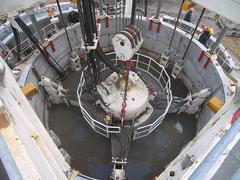
|

This presentation is part of the series of presentations "Utility Tunnelling" and deals with the building of starting and target shafts and the design of exit and entry openings. |
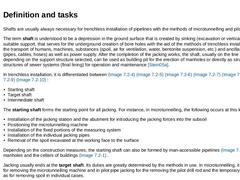
|
Shafts are usually always necessary for trenchless installation of pipelines with the methods of microtunnelling and pilot pipe jacking. The term shaft is understood to be a depression in the ground surface that is created by sinking (excavation or vertical boring), with suitable support, that serves for the underground creation of bore holes with the aid of the methods of trenchless installation and for the transport of humans, machines, substances (… |